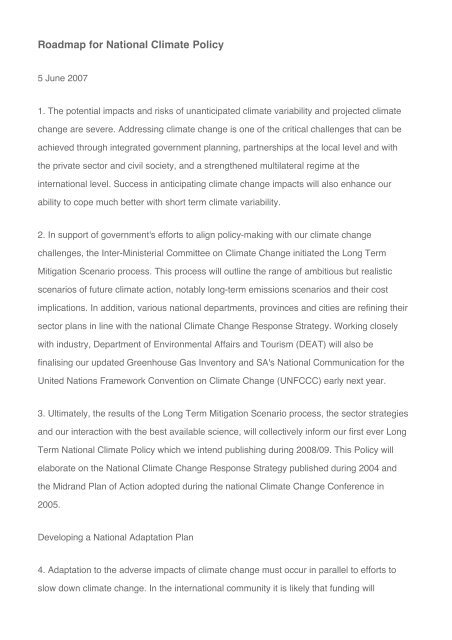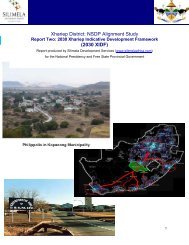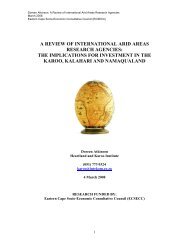Roadmap for National Climate Policy - Arid Areas Programme
Roadmap for National Climate Policy - Arid Areas Programme
Roadmap for National Climate Policy - Arid Areas Programme
Create successful ePaper yourself
Turn your PDF publications into a flip-book with our unique Google optimized e-Paper software.
<strong>Roadmap</strong> <strong>for</strong> <strong>National</strong> <strong>Climate</strong> <strong>Policy</strong>5 June 20071. The potential impacts and risks of unanticipated climate variability and projected climatechange are severe. Addressing climate change is one of the critical challenges that can beachieved through integrated government planning, partnerships at the local level and withthe private sector and civil society, and a strengthened multilateral regime at theinternational level. Success in anticipating climate change impacts will also enhance ourability to cope much better with short term climate variability.2. In support of government's ef<strong>for</strong>ts to align policy-making with our climate changechallenges, the Inter-Ministerial Committee on <strong>Climate</strong> Change initiated the Long TermMitigation Scenario process. This process will outline the range of ambitious but realisticscenarios of future climate action, notably long-term emissions scenarios and their costimplications. In addition, various national departments, provinces and cities are refining theirsector plans in line with the national <strong>Climate</strong> Change Response Strategy. Working closelywith industry, Department of Environmental Affairs and Tourism (DEAT) will also befinalising our updated Greenhouse Gas Inventory and SA's <strong>National</strong> Communication <strong>for</strong> theUnited Nations Framework Convention on <strong>Climate</strong> Change (UNFCCC) early next year.3. Ultimately, the results of the Long Term Mitigation Scenario process, the sector strategiesand our interaction with the best available science, will collectively in<strong>for</strong>m our first ever LongTerm <strong>National</strong> <strong>Climate</strong> <strong>Policy</strong> which we intend publishing during 2008/09. This <strong>Policy</strong> willelaborate on the <strong>National</strong> <strong>Climate</strong> Change Response Strategy published during 2004 andthe Midrand Plan of Action adopted during the national <strong>Climate</strong> Change Conference in2005.Developing a <strong>National</strong> Adaptation Plan4. Adaptation to the adverse impacts of climate change must occur in parallel to ef<strong>for</strong>ts toslow down climate change. In the international community it is likely that funding will
increasingly be made available to sensible, innovative and effective adaptation plans. We inSouth Africa should position ourselves to be amongst the leaders in these ef<strong>for</strong>ts, and togain from this trend in a way that will yield long term benefits.5. A number of departments and institutions, not least the Departments of Water Affairs andForestry, Agriculture, and Science and Technology have made major strides in integratingplanning and strategies to adapt to climate change with their research, development andimplementation frameworks. Though the Long Term Management Strategy (LTMS) processis primarily mitigation focused, it will also produce a valuable in<strong>for</strong>mation base that couldassist us in taking <strong>for</strong>ward our work on adaptation. DEAT and the South African WeatherService (SAWS) is also up-scaling our ef<strong>for</strong>ts on atmospheric monitoring, which will provideinvaluable baseline data <strong>for</strong> future adaptation work.6. DEAT will build on the outputs of our UNFCCC <strong>National</strong> Communications (to becompleted early next year) and the progress achieved by our partners in other departmentsand institutions to design a process that will, over the next few years, match our ef<strong>for</strong>ts onthe mitigation scenario building process. This will eventually lead to the development of a<strong>National</strong> Adaptation Plan. This process will initially be aimed at integrating and collating theexisting work on adaptation and on the basis of this identify a medium term programme toaddress the gaps in our current knowledge base.7. Within DEAT's portfolio, a priority area of work in this context deals with the impacts ofclimate change on key environmental assets. These include especially our natural heritagein the most threatened eco-systems and conservation areas of this country, marineresources and ecosystem goods and services that support so many livelihoods andmaintain our environmental health and integrity.Dealing with the impacts of climate change on key environmental assets8. Last month, the Intergovernmental Panel on <strong>Climate</strong> Change confirmed that climatechange is emerging as the single greatest driver of biodiversity loss, and as such will bymid-century have a dramatic impact on key eco-systems, conservation areas, marine
esources, and potentially tourism.9. It stands to reason that tourism could be affected by climate change through acombination of loss of biodiversity, and changes in temperature, humidity and risk climatesensitivediseases and other invasive organisms. Nature based tourism and wildlife arecited by some 30% of international visitors as key attractions in conservation areas andbeyond. With tourism contributing just over eight percent of our Gross Domestic Product(GDP), the economic impact of climate change on tourism could be very large indeed. Thisdoes not include the more direct market impacts of climate change, e.g. on agriculture,invasive species, water resources and non-market impacts, e.g. the existence value ofbiodiversity, the subsistence use of natural resources and the impacts on human health.10. Globally, by mid century, 20% to 30% of plant and animal species are likely to be atincreased risk of extinction as a result of climate change. Closer to home, in sub-SaharanAfrica, the Intergovernmental Panel on <strong>Climate</strong> Change (IPCC) indicated that between 25%and 40% of animal species in national parks will see further increases in threat status.South African Fynbos and the Succulent Karoo ecosystem seem particularly vulnerable and<strong>for</strong> a mean global temperature increase of between two and three degrees celsius duringthis century, we stand to lose between 50% and 65% of our unique Fynbos.11. Potential shifts in the strength and position of the Benguela current upwelling systemthat supports South Africa's most productive fishery are also indicated.12. In conservation areas the threats appear to be real and urgent. For example:* Kruger <strong>National</strong> Park: more intense rainfall interspersed with possibly more extended dryspells, changes in the tree cover and grass production, greater competition <strong>for</strong> water withwater users upstream of the park.* Hluhluwe-Imfolozi Park: aggressive bush encroachmentand spread of biodiversity-choking invasive plants such as triffid weed.* Table Mountain<strong>National</strong> Park: local extinctions of climate-sensitive fynbos species with possible loss ofsensitive habitats such as ancient perennial water seeps, increased frequency of fires,accelerated spread of alien invasive species.* Addo: greater frequency of intense rainfall
events interspersed with longer droughts* Isimangaliso Wetland Park: gradual sea level riseleading to increased salinity and species loss in wetlands, and in conjunction with extremestorm events and possible degradation of mangroves that act as natural barriers againststorm surges* Kgalagadi Transfrontier Park: extreme temperature increase leading to diebackof key species such as observed in the desert quiver tree, and even remobilisation ofthe Kalahari dune system over decades* Tanqua Karoo <strong>National</strong> Park and other protectedareas of the Succulent Karoo: very likely increased risk of extinction of tens to hundreds ofendemic succulent species over the next few decades* Coastal wetland bird sanctuaries:salinisation and degradation due to sea level rise and storm surges may threaten theintegrity of these ecosystems with threats especially <strong>for</strong> migrant species; greaterunpredictability of rainfall may threaten bird species dependent on seasonal water bodies.13. In order to preserve our magnificent heritage and key environmental assets, and ensurethat it is passed on intact to the children and grandchildren of this nation, and indeed theworld, we have to recognise that our knowledge base is incomplete. Within DEAT's portfolio,we will focus pro-actively on enhancing research on the impacts of climate change on keyenvironmental assets, and in support of ecosystem planning, biodiversity management (alsooutside parks), the management of marine resources, park management and climatechange adaptive plans. This will be achieved through strong cross-disciplinary approachesand by working closely with the funders of science, such as Department of Science andTechnology (DST), and academic institutions.New international partnerships to enhance domestic implementation14. Over the past year we have enhanced our capacity <strong>for</strong> domestic implementation througha number of international partnerships.India-Brazil-South Africa (IBSA): In December 2006, I agreed with my counterparts fromIndia and Brazil that the initial cooperation framework <strong>for</strong> the IBSA <strong>Climate</strong> Change WorkingGroup will focus on strengthening IBSA South * South cooperation on climate change, andcoordination during the negotiations and actions under the UNFCCC and other relevantinternational initiatives. This will eventually be expanded to include scientific exchange,
student exchange, technology transfer, and technology R&D cooperation.Australia: South Africa and Australia both need to implement policies and measures in thebiodiversity sphere and also in the agricultural sector. Through practical joint activities andmutual learning, we will enrich our respective domestic programmes to adapt to thedevastating impacts of climate change with a view to conserving our rich biodiversity, andachieving improved food security. In terms of mitigation, we will share expertise ongreenhouse gas emissions reporting and monitoring, and exchange experiences andlessons learned on climate change policies and measures - with a particular focus on cleancoal technologies and regulatory and institutional frameworks.United Kingdom (UK): Under the South Africa-UK High-Level Dialogue on SustainableDevelopment, which includes cooperation on energy <strong>for</strong> sustainable development,environmental en<strong>for</strong>cement, mainstreaming sustainable development, and sustainableconsumption and production, we have established a Working Group on <strong>Climate</strong> Change.The working group on climate change will <strong>for</strong>mulate a full programme including work on theadaptation and impacts. It has already agreed to undertake joint research work on possible<strong>for</strong>ms of long-term global action on climate change.European Commission: South Africa and the Commission established a <strong>for</strong>mal dialogue andjoint cooperation <strong>for</strong>um on the environment and sustainable development, with a specificworking group focusing on issues relating to climate change. This area of work will focus onpolicy dialogue and implementation of respective commitments under the United NationsFramework Convention on <strong>Climate</strong> Change, the Kyoto Protocol and other climate changerelated projects or programmes such as adaptation, renewable energy, energy efficiency,disaster management, research, technology development and deployment.Enquiries:Riaan AucampCell: 083 778 9923Issued by: Department of Environmental Affairs and Tourism






